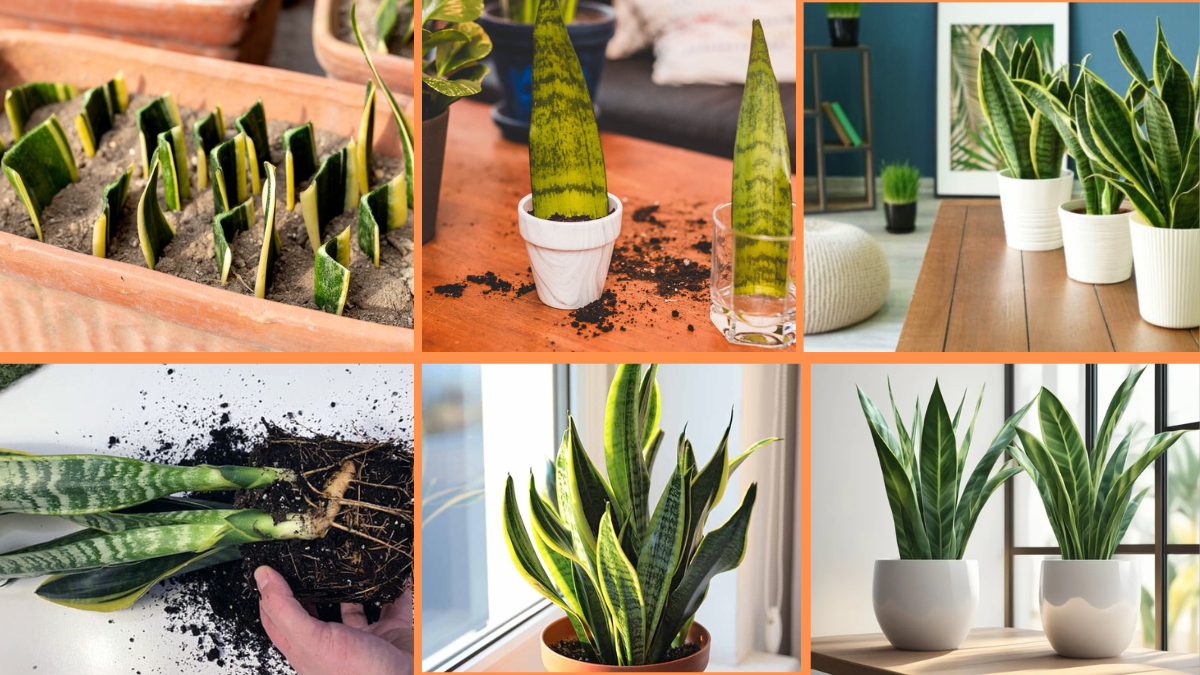If you’re looking for a hardy, stylish, and nearly indestructible houseplant, the snake plant is your perfect match. Also known as Sansevieria or mother-in-law’s tongue, this bold, upright plant is famous for its striking, sword-shaped leaves and remarkable resilience.
Ideal for both new and seasoned plant lovers, snake plants are low-maintenance, thrive on neglect, and can survive in a variety of indoor conditions. In this comprehensive guide, we’ll walk you through how to start growing snake plants, including tips on planting, caring, propagating, and troubleshooting common issues.

Why Choose Snake Plants?
Before we dive into the growing process, let’s see why snake plants are a favorite for homes and offices:
- Extremely low-maintenance — great for beginners.
- Tolerates low light, drought, and inconsistent care.
- Natural air purifiers; remove toxins like benzene, formaldehyde, and xylene.
- Stylish, architectural look suits modern and traditional décor.
- Can thrive both indoors and outdoors in warm climates.
Fun Fact: NASA’s Clean Air Study ranked snake plants among the top air-purifying plants for indoor environments.
Popular Types of Snake Plants
Though the classic green variety is the most recognized, there are many beautiful types of snake plants to choose from:
Sansevieria trifasciata ‘Laurentii’
- Tall, upright leaves edged with bright yellow.
- Most common variety in homes.
Sansevieria cylindrica
- Cylindrical, spiky leaves that grow vertically.
- Can be braided or left standing tall.
Sansevieria ‘Moonshine’
- Soft, silvery-green foliage.
- Elegant and less common.
Sansevieria trifasciata ‘Hahnii’
- Compact, bird’s nest shape.
- Perfect for small spaces and tabletops.

How to Grow Snake Plants Indoors
Growing snake plants is refreshingly simple. Here’s how to do it right:
Step 1: Choose the Right Pot and Soil
Snake plants prefer slightly tight spaces, so select a pot just 1-2 inches larger than the root ball. Ensure it has drainage holes.
Use a well-draining, sandy soil mix. A good cactus or succulent mix works well. You can also make your own by mixing:
- 2 parts potting soil
- 1 part perlite or pumice
- 1 part coarse sand
Step 2: Find the Ideal Spot
Snake plants are adaptable but thrive best with:
- Bright, indirect light (but tolerate low light)
- Away from cold drafts and direct hot sun, which can scorch leaves
Pro Tip:
In offices or rooms with minimal windows, snake plants remain one of the few plants that can still survive.
Step 3: Planting
- Fill the bottom of the pot with soil.
- Position the snake plant in the center.
- Fill around the roots with more soil, pressing lightly.
- Water lightly after planting to settle the soil.

How to Care for Snake Plants
Once planted, snake plants require very little upkeep.
Watering
Less is more for snake plants.
- Allow soil to dry out completely between waterings.
- Water about every 2-6 weeks, depending on light and humidity.
- In winter, reduce watering frequency.
Tip:
Always check the soil with your finger; water only if the top 2 inches are dry.
Temperature and Humidity
- Prefer temperatures between 60-85°F (16-29°C).
- Tolerate low humidity but also thrive in average indoor air.
Avoid exposing them to temperatures below 50°F (10°C).
Fertilizing
Feed sparingly. Use a balanced liquid fertilizer diluted to half-strength once a month during the growing season (spring and summer). No fertilizer is needed in fall and winter.
Pruning
- Remove yellow, damaged, or old leaves at the base with clean, sharp scissors.
- Pruning encourages new, healthy growth.

How to Propagate Snake Plants
One of the joys of snake plants is how easily they propagate. Here are three reliable methods:
1. Leaf Cuttings in Water
- Cut a healthy leaf into 4-6 inch sections.
- Let cut ends dry for 1-2 days.
- Place the cut end in water, ensuring the cut side faces down.
- Change water weekly.
- Roots and new pups form in a few weeks.
2. Leaf Cuttings in Soil
- Cut a leaf into sections.
- Allow ends to dry for 1-2 days.
- Plant cuttings in a well-draining soil mix.
- Keep soil lightly moist (not soggy) until new growth appears.
3. Division
The quickest method:
- Remove the plant from its pot.
- Gently separate clumps or sections with roots attached.
- Replant each section in a new pot.

Common Problems and Solutions
Though hardy, snake plants can encounter a few issues. Here’s how to fix them:
| Problem | Cause | Solution |
|---|---|---|
| Yellow, mushy leaves | Overwatering or poor drainage | Remove affected leaves and repot in dry soil |
| Brown leaf tips | Low humidity, drafts, or underwatering | Trim tips and adjust watering routine |
| No new growth | Low light or overwatering | Move to brighter spot and reduce watering |
| Pests (mealybugs, spider mites) | Dry air or poor air circulation | Wipe leaves with neem oil or insecticidal soap |
Growing Snake Plants Outdoors
In warm, frost-free regions (USDA Zones 9-11), snake plants can thrive outdoors year-round.
Tips for outdoor care:
- Plant in well-draining soil.
- Place in bright, indirect sun or dappled shade.
- Water sparingly, especially in rainy seasons.
In colder climates, snake plants make excellent summer patio plants but should be brought indoors when temperatures drop below 50°F (10°C).

Fun Facts About Snake Plants
- Snake plants are one of the most oxygen-producing houseplants.
- They release oxygen at night, making them ideal for bedrooms.
- Used in traditional medicine in parts of Africa and Asia for healing wounds and purifying the air.
- Believed in Feng Shui to bring protective energy and wealth luck.
Final Thoughts
Snake plants are everything a houseplant should be — strikingly attractive, almost indestructible, and beneficial to your home environment. With minimal care, they thrive in spaces where most other plants struggle, making them the perfect addition to any room or outdoor garden.
Whether you choose the classic green-and-yellow ‘Laurentii’, the silver-toned ‘Moonshine’, or the bold Sansevieria cylindrica, you’ll enjoy a hassle-free, oxygen-boosting plant that keeps your home looking fresh and modern.
So go ahead — pick up a snake plant today, and discover firsthand why this humble houseplant has become a global favorite.





